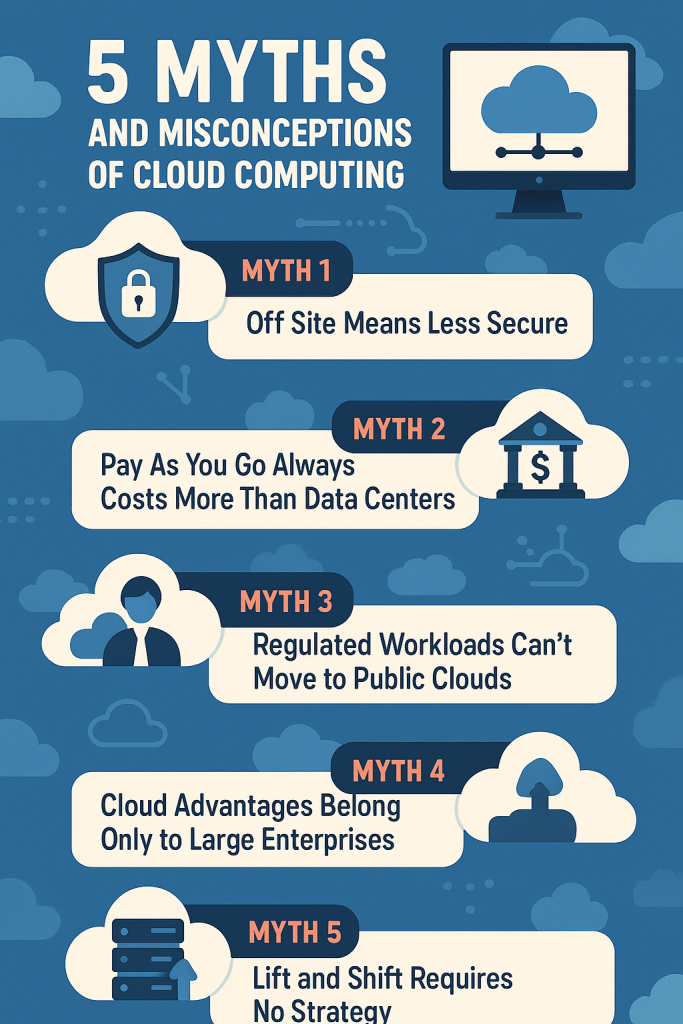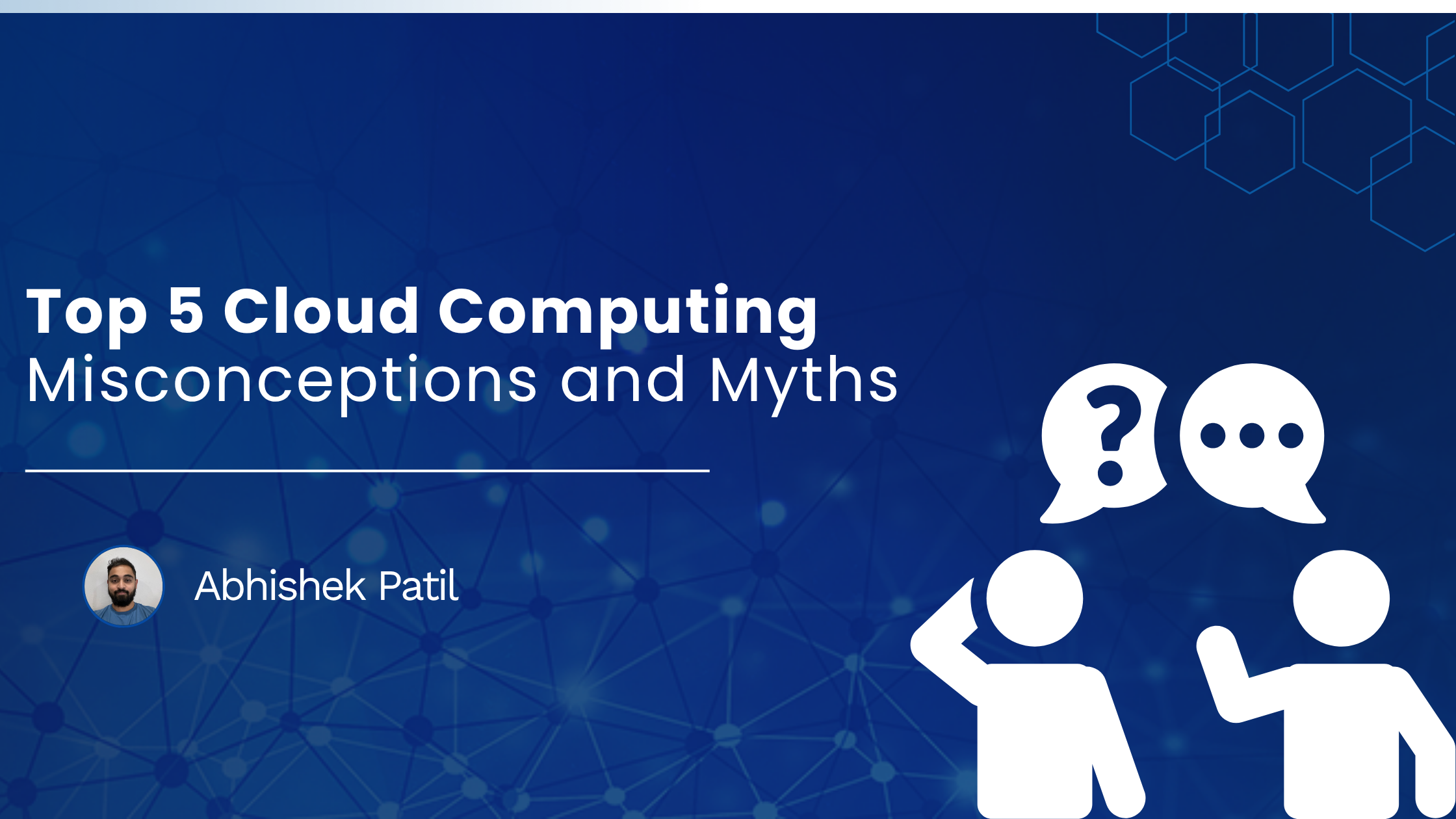Cloud computing has transformed how organizations build, deploy, and manage applications and services. Yet, myths rooted in yesterday’s realities can obscure today’s possibilities. In this blog, we unpack five pervasive misunderstandings, show why each no longer applies, and point you to up-to-date perspectives from trusted technology media and analyst reports.

Myth 1: Off-Site Means Less Secure
Why It Persists
Early cloud offerings lacked mature security controls, and many teams equated physical hardware ownership with stronger protection. That view overlooked the resources hyperscale providers pour into security research, dedicated teams, and compliance.
Current Reality
Modern cloud platforms embed advanced threat defenses, automated patching, and granular identity frameworks at scale — features that many enterprises struggle to replicate on-premises. Generative AI now enables real-time anomaly detection and adaptive policy adjustments, stopping threats before they spread. For example, AI-driven security models analyze network telemetry and user behavior to predict breaches, shifting from reactive to proactive defenses.
Beyond AI, hyperscalers maintain hundreds of security certifications (ISO 27001, FedRAMP, HIPAA) and operate Security Operations Centers (SOCs) staffed 24/7. In Microsoft’s 2024 State of Multicloud Security Report, 75% of respondents reported a stronger security posture after adopting native cloud controls and zero-trust methods, compared with their previous on-premises baselines.
Myth 2: Pay-As-You-Go Always Costs More Than Data Centers
Why It Persists
Cloud bills itemize compute, storage, and network charges, so it’s tempting to compare them directly with capital expenditures. Still, this simple comparison omits hidden on-premises expenses: power, cooling, real estate, hardware refresh cycles, and specialized staff.
Current Reality
According to a recent cloud report, managing cloud spend topped security as the number-one challenge for the second consecutive year. However, 57% of enterprises using multicloud FinOps tools report lower total cost of ownership compared with static data centers. These tools automate rightsizing, idle-resource shutdowns, and reserved-instance purchases, all of which are practices that often yield 20 to 30% savings.
Furthermore, cloud financial operations (FinOps) teams are growing: over half of large organizations now maintain dedicated FinOps roles, leveraging dashboards that track budget versus forecast in real-time. When cost spikes occur, automated alerts drive immediate action, avoiding surprise overages that plague on-prem refresh cycles.
Myth 3: Regulated Workloads Can’t Move to Public Clouds
Why It Persists
Perceptions remain that strict regulations like HIPAA, PCI-DSS, FedRAMP, and NIS2 mandate private infrastructure. The idea is that only on-premises truly meets compliance demands.
Current Reality
Hyperscalers have built compliance portfolios covering nearly every industry standard, complete with audit logs, data-residency controls, and region-specific certifications. Microsoft Azure, for instance, offers integrated tools like Azure Arc, Policy, Defender for Cloud, and Sentinel that automate NIS2 risk assessments, reporting, and enforcement across hybrid estates.
These services extend Azure’s security stack to on-premises and other clouds, giving regulated organizations unified visibility and control. A recent Microsoft case study describes how a European healthcare provider met GDPR and NIS2 requirements within weeks by applying Azure’s compliance blueprint and continuous-monitoring policies without building new data centers.
Myth 4: Cloud Advantages Belong Only to Large Enterprises
Why It Persists
Early adopters were Fortune-500 firms with deep pockets and skilled teams. Smaller organizations saw cloud as out of reach or as risky experimentation.
Current Reality
Cloud democratizes access to advanced services, such as AI, analytics, global CDN, and managed databases, without upfront hardware investments. In fact, small and medium businesses (SMBs) lead public cloud adoption, where 61% of SMB workloads now run in the public cloud, only a slight dip from last year’s 67%.
Moreover, the 2024 Gartner Magic Quadrant for Distributed Hybrid Infrastructure spotlights platforms, both on-premises and cloud, that serve organizations of any size with consistent management, security, and support across environments. There are a handful of providers today that deliver turnkey models that scale from regional offices to global estates, enabling SMBs to access the same resilience and automation once reserved for the largest enterprises.
Myth 5: Lift-and-Shift Requires No Strategy
Why It Persists
The simplicity of copying VMs or containers to the cloud leads some to believe “it just works” with minimal effort.
Current Reality
Surveys indicate that more than 40% of cloud migrations experience delays, cost overruns, or rework due to inadequate assessment and planning. PwC’s 2024 study names skills gaps as a top barrier, where four in ten enterprises cite a lack of cloud expertise as a significant drag on migration.
Successful transitions rely on:
- Comprehensive Assessment: Inventory applications, dependencies, and compliance needs.
- Architecture Alignment: Decide which workloads suit rehosting, refactoring, or replacement.
- Governance Frameworks: Define roles, budget controls, and security policies upfront.
- Skill Building: Invest in training or partner with experienced integrators to cover gaps.
According to TechTarget, inadequate planning leads to 27% more post-migration incidents, including performance regressions and unexpected egress fees. By contrast, organizations that adopt a phased approach — pilots, iterative optimizations, and continuous monitoring — cut incident rates by half.
Cloud platforms today offer mature security, cost control tools, compliance automation, and scalability for large and small organizations. Dispelling these five myths opens the door to smarter cloud adoption that is grounded in current capabilities, not outdated fears. With careful planning and the right tools, teams can harness cloud computing as a strategic asset rather than a leap into the unknown.
Now that we’ve busted the myths of present-day cloud computing, the next thing you need to understand is how to protect such complex architecture.
How to Safeguard Your Cloud Computing Environment
Looking for the best, most efficient way to protect your cloud? Then look no further than SecPod. With SecPod’s latest CNAPP offering, Saner Cloud, you gain access to a turnkey path from onboarding all the way through to continuous monitoring and automated remediation. Let’s take a look at some of Saner Cloud’s next-gen capabilities.
Streamlined Onboarding & Credential Security
- Automated Role Stack Creation: If you’re already signed into AWS, Saner Cloud can spin up the necessary IAM roles automatically with no manual scripting required.
- Encrypted Credential Integration: Whether it’s AWS access keys or Azure tenant credentials, Saner Cloud encrypts and stores them securely, making sure that only authorized scans and actions occur.
Multifactor Authentication (MFA)
Enable PingOne MFA or Google Authenticator to add a second layer of defense for every user. Saner Cloud supports SMS, email, and authenticator-app delivery options so you can tailor authentication to your team’s needs.
Continuous Discovery & Automated Responses
- Ongoing Scans: Once onboarded, Saner Cloud runs continuous discovery scans to spot misconfigurations, missing patches, or exposed assets as frequently or continuously based on your preferred settings.
- Pre-built Remediation Playbooks: Define automatic fixes or whitelisting rules so anomalies get addressed immediately without the hassle of manual intervention.
AI-Powered Insights & Compliance Benchmarking
- Generative AI Summaries: Complex graphs and tables become human-readable summaries you can paste directly into reports.
- SecPod Default Benchmark: Out-of-the-box compliance checks against NIST, CIS, PCI-DSS, HIPAA, SOC2, and more, plus the ability to create custom benchmarks for your specific regulatory needs.
Actionable Dashboards & Alerts
- CSPM & CSAE Views: Get a live, sortable view of your security posture, public exposures, outdated resources, cost/usage trends, and watchlists in a single pane.
- Pre-defined Alert Conditions: Receive instant notifications for failed CIS controls, unauthorized access attempts, aging patches, or any other events you choose to monitor.
Ready to Fortify Your Cloud? Experience hands-on how Saner Cloud transforms complexity into clear, actionable security. Start your free trial and see our AI-fortified CNAPP in action today.

